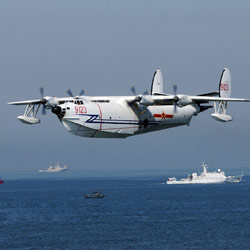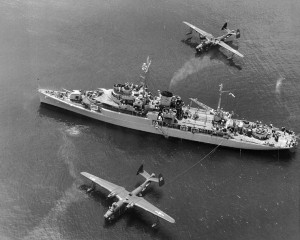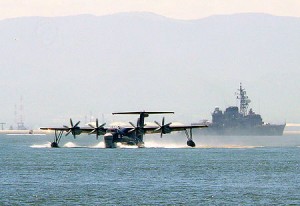 A good deal of polite Western snickering met the announcement that China was on the verge of building large seaplanes–an “old technology”, scoffed the haters, whose “heyday came and went with the demise of the Pan Am Trans-Oceanic Clipper”.
A good deal of polite Western snickering met the announcement that China was on the verge of building large seaplanes–an “old technology”, scoffed the haters, whose “heyday came and went with the demise of the Pan Am Trans-Oceanic Clipper”.
But at least one Chinese aviation commentator dispensed a bit of wisdom for the doubters:
“The old saying ‘A thousand days the country nurtures its soldiers and all for one day’s battle’ applies to the development of amphibious aircraft. People say such equipment is becoming useless, but will eventually realize they are indispensable in maritime operations,”
The lesson is pretty clear–don’t dismiss old-looking tech.
And he’s right.
What looks like a useless piece of equipment to many of Washington’s vaunted hunters of “fifth and sixth-generation opponents”, is, in reality, the poor man’s MV-22. When fielded, these big amphibious planes will do a darn good job of disrupting the modern maritime battlefield.
Amphibious aircraft make a great, cost-effective means for littoral power projection.
Seaplanes also offer a great way to start building a corps of operators prepared to intuitively understand the speed and range advantages (and the attendant weaknesses!) of MV-22.
Seaplane users are not encumbered by prior rotary wing doctrine. And I’ll wager that seaplane drivers will grasp the utility of the MV-22 far faster than, say, your traditional rotary-wing expert (Observers have seen just how hard it has been in the United States to get the U.S. Marine Corps, the primary MV-22 customer, to really understand that the MV-22 isn’t a 1-for-1 replacement for a helicopter).
I mean, why do you think Japan “gets it”, and is moving so quickly to adopt the MV-22? I think that having been a long-time seaplane consumer (using Shinmaywa US-1a’s and US-2s to service and patrol dispersed island holdings) has a good bit to do with it. It is a better conceptual match. Yes, the MV-22 remains a pricey, high-tech and high-maintenance platform in comparison to the average seaplane, but it is arguably a better–and more utilizable–1-for-1 replacement for the seaplane’s niche mission.
There are also a few strategic components here that are worth considering.
First, the adoption of old-tech platforms is a neat means of exploiting a traditional U.S. habit of mirror-imaging and overlooking history. Call it a form of third-world stealth–employment of old-school tech almost guarantees the West’s vast intelligence-gathering and threat-detection infrastructure will dismiss the anomaly and pass on to more “exciting” targets.
Think about it. Before news of China’s South China Sea dredging projects broke, I discussed America’s failure to intuitively grasp the value of island holdings–by rejecting, out of hand, the potential for countries to engage in massive feats of environmental engineering, transforming reefs into airfields and harbors. I mean, who in the West, in this day and age of environmental regulation and environmental impact studies, even thinks of such stuff anymore?? And, well, guess what? American policymakers were taken by surprise when China set about terraforming their reef holdings.
What’s crazy is that the United States did exactly the same thing in the ’30s, ’40s…to the ’60s. America shouldn’t have forgotten. But Washington did.
That initial failure to appreciate history lost American policymakers an opportunity to get ahead of the South China Sea problem, shifting from crisis response into actively getting about seizing the initiative.
You see, American observers sure didn’t appreciate that Johnson Atoll, Tern Island, Midway, Wake and many other advanced Pacific Island airstrips built before World War II began as humble seaplane base dredging projects.
The spoil from those seaplane bases ended up making pretty serviceable airstrips (All that excess coral had to go somewhere, right?). Tern Island grew from a reef to an airstrip of just 30 acres, but it was a darn useful thirty acres.
America’s oversight contributed to what seems like another round of hasty, poorly planned reactions to Chinese provocations–I mean, is anybody really surprised this seaplane announcement came on the heels of a hasty request for a moratorium on development in the South China Sea?
If U.S. analysts had appreciated the historical trends in island fortification and development, America could have started managing the challenge. There were plenty of opportunities. When word started filtering out five years ago that China was developing large indigenous seaplanes….well, let’s just say that it was something of a mighty big “tell” and a sign of what was coming.
American South China Sea policymakers should have been alerted right then and there.
(Other tells just might also have been the recent surge in friendly Chinese investment in seaplane companies throughout the world–particularly after China’s tiny amphibious fleet suffered a “training” crash in 2013. My assumption is that China needed a little glimpse at how other folks were shaping their amphibian’s unique and tough-to-engineer landing surfaces.)
But that’s just water under the bridge.
And now, big seaplanes are getting ready to enter the Chinese arsenal–operating, certainly, from those nicely dredged channels around some of China’s seized South China Sea “sea features/future airfields”. So….get ready for more South China Sea fun, because these seaplanes offer some interesting disruptive potential.
Here’s what they offer:
Trial production of the TA-600 aircraft, formerly known as Dragon-600, will start in Zhuhai, Guangdong province, around the end of this year or the beginning of 2015, as the design has been completed, said Fu Junxu, a senior manager of China Aviation Industry General Aircraft, a subsidiary of Aviation Industry Corp of China, the country’s leading aircraft maker.
Fu said contractors will deliver large parts to the company before the end of this year, and the aircraft’s maiden flight is planned to take place in 2015.
The aircraft, with a maximum takeoff weight of 53.5 metric tons and a maximum range of more than 5,000 kilometers, will be larger than a Boeing 737 and could be used for a variety of operations such as passenger transport, marine environmental monitoring, firefighting and maritime search and rescue, Fu said.
Powered by four turbine engines, the TA-600 will be the world’s largest amphibious aircraft, surpassing Japan’s Shin Maywa US-2. It is designed to carry up to 50 people during search and rescue missions.
 Don’t Dismiss Amphibious Planes:
Don’t Dismiss Amphibious Planes:
To sum up, Western defense thinkers dismiss China’s new amphibians at their own peril.
Amphibious aircraft are not quaint throwbacks to a bygone era. They’re useful, and they’ll be a cheap Chinese surrogate for an MV-22-like capability in the Pacific. And their disruptive potential extends beyond the South China Sea, too. It’s high time to lock some folks in a room to consider how a rapidly-arriving force of seaplane-borne Chinese “Peacekeepers” might seriously complicate the too-oft-ignored geopolitical backwater that is the Pacific Basin. Lots of ethnic Chinese are out there, and anti-Chinese race riots are ugly, vicious and regular events throughout the Pacific.
Dismiss me as shrill, but I insist that there is a plan for these things. It’s just too darn convenient that design of China’s big amphibs got started in late 2009, just before China declared that the South China Sea was a “core interest”. These beefy amphibious transports may be old technology, but they have a whiff of being a well-thought-through requirement.
I sure hope I am wrong. But I fear this is just going to be another in a long line of otherwise unanticipated moves in China’s increasingly transparent effort to, essentially, assimilate Southeast Asia.



{ 13 comments… read them below or add one }
‘Beijing ups the stakes in South China Sea with successful trials of new amphibious aircraft’
South China Morning Post
08 September 2018, 23:25
Kristin Huang
Good call Craig.
thx!
It’s also important to note that there are no runways to crater to suppress these aircraft, and they can operate from any body of water large and deep enough, which is a VERY long list.
Amphibian aircraft are among the most underrated flying machines in the world.
I’ve always advocated a C-130 seaplane version and LockMart designed one, but the Marines never showed interest. A new C-130J costs less than a V-22, but carries five times the payload three times farther and much faster and is not broke down half the time.
A V-22 can VSTOL, but with limited payload. During the Libyan rescue, each V-22 carried just a few Marines while CH-53Es flew alongside with most of the landing force. In the Philippines relief effort, V-22s stayed on hard surface runways and operated like aircraft, not venturing out to do VTOL things from nearby ships.
The 2012 CV-22 mishap report is of interest. The aircraft flipped over and crashed from the wake of another V-22 flying three football fields away.
http://usaf.aib.law.af.mil/ExecSum2012/CV-22B%2C%20Hurlburt%2C%2013%20Jun%2012.pdf
The crew escaped, but as another CV-22 attempted to hoist away survivors:
“The MLA hovered over the crash site, hoisted the MCP and began circling the crash site in airplane mode in an attempt to cool down their proprotor gearbox, which had begun heating up (Tab V-6.7 and V-7.6). The MLIF and the MLEF continued providing care to the injured members of the MC and determined that due to the amount of downwash the MLA had produced on their previous hoist that it would be more harmful than helpful to hoist out any other injured crewmembers.”
So they waited for a civilian helo to show up. And since the V-22 has a lightweight flammable fuselage, it caught fire and burned up the aircraft. The crew was lucky to escape.
Nobody seems to care that Bell abandoned its civilian tiltrotor effort and introduced a new medium lift helo at the same time. http://www.flyingmag.com/aircraft/helicopters/bell-525-relentless-redefines-heli-market.
Boeing has never bothered to attempt selling a civilian version of the V-22 since the FAA would not certify tiltrotors as safe for passengers. Note that Marines assigned several V-22s to support HMX-1, the President’s helo support squadron, but not for use by the President, a new helo has been selected for that role.
Japan is not quickly moving to buy V-22s, which have been in production for two decades. Bell abandoned its civilian program after failing to gain FAA certification due to safety concerns and after an American expert from IDA reported it unsafe: http://www.atimes.com/atimes/Japan/NG10Dh01.html
So far, someone in Tokyo suggested that Japan might fund some V-22s in its 2015 budget. That is all, but is part of the never ending sales pitch that some fools other than the Marines are buying the V-22. (Hagel forced Israel to accept six as gifts) Meanwhile, the Marines deactivated two VMM squadrons (561 and 562) and increased its buy by 24 to 384 to compensate for dozens of unreported scrappings. http://www.g2mil.com/V-22Amishaps.htm
Chris–I would think that, for the USN, the MV-22 is already making a play for this niche. That said, it might be nice having a large, long-range cargo-hauler that’s a bit speedier than the CH-53K for those out-of-the-way places…
The USN may want to revisit its seaplane legacy for logistics support if you would like to consider operations from undeveloped islets in the western Pacific in the event Chinese IRBM and MRBMs make established ports and bases too hot to pull into.
Re: Terraforming
Don’t forget the US turning a useless little islet into the “concrete battleship” with two twin 14″ gun turrets in the mouth of Manila Bay. It went from a useless rock to a permanent unsinkable battleship — still there.
The Chinese could do a lot more than move sand, and create a lot more than a flat place on the ocean. What they have done so far is a mere begining on what is possible.
Andy–True, but hey, the modern alternative–the MV-22–has pretty high maintenance costs too. But in places like WestPac, these old things are still useful–there are plenty of places where water is pretty protected, and, with a little dredging, they can support seaplanes 24/7…
Beautiful plane but airframe maintenance costs are huge w seawater corrosion and perfect conditions are reqd for landing. Any roughness and the plant gets torn up and the crew imperiled. May still have it’s place tho.
Great article. modern emphasis on platform, ignores the fact that advanced weapons/sensors/capabilities can be carried by legacy craft, of all types. and it is THOSE weapons/sensors, etc. that are the danger, not the platforms.
re: seaplanes……..how ’bout an increase, just for funs?
combo Ekranoplane and……airship.
you might enjoy reading at the blog site above (a fiction; but telling….)
Hi Chris–I would agree with you about the operator–one of China’s less militarized law enforcement wings would be a nice fit. Heck, I could see some sort of quasi state-owned civilianized outfit working this just to pump civilians into the region and get bonus points for supporting civilian transit (and offering fast transport of Authentic! South China Sea! Fish! to market)
That said, I think Navy still runs China’s existing handful of big but aged seaplanes. If the new aircraft were going to be for the China Maritime Safety Administration or Ministry of Fisheries or Xi’s Government-Owned Cigarette Smuggling Division of Whomever Is In Favor This Friday, I’d expect the old craft to have already been dolled out to the future operators.
Conceptually they seem to fit very nicely with the other observed activities in the South China Sea. As an alternate means of logistic resupply or reinforcement of island garrisons, they seem ideal. The aircraft are largely unthreatening with legitimate uses in maritime patrol and Search and Rescue, and conveniently less susceptible to underwater warfare. They are also considerably less overtly confrontational than the Ekranoplane.
I would be surprised if they are not seen in the SCS although I doubt they would be operated by the PLA. I expect they would be a Coast Guard asset which would assist in keeping the activities below the military threshold.